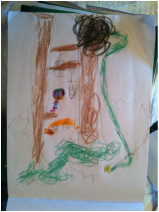My Teaching Philosophy

As children, everyone creates art whether it’s on a canvas or in the sand of a sandbox. Art allows humans to be creative and expressive through any medium imaginable. Often, art is looked at as a final product; however, it is equally as important to look at the process and thought that goes in to creating the artwork.
In art, students can put everything else on pause and take a portion of their day to create. Art allows students to let go of the need for perfection and instead become explorers of themselves and the world around them. Students are curious and eager to find new problems and solutions. Art classrooms give students the opportunity to explore their curiosities, learn from their failures and earn a sense of accomplishment. It’s incredible to see how art allows students to stand apart but then come together to reflect and collaborate. There is no one reason why we create art; it changes from person to person.
Planning and Preparation - It's important to be prepared in order to create a successful classroom environment
When students create art they:
In art, students can put everything else on pause and take a portion of their day to create. Art allows students to let go of the need for perfection and instead become explorers of themselves and the world around them. Students are curious and eager to find new problems and solutions. Art classrooms give students the opportunity to explore their curiosities, learn from their failures and earn a sense of accomplishment. It’s incredible to see how art allows students to stand apart but then come together to reflect and collaborate. There is no one reason why we create art; it changes from person to person.
Planning and Preparation - It's important to be prepared in order to create a successful classroom environment
- Make sure students will have access to all materials needed
- Create lesson plans that are intriguing and pertinent to students
- Gather all needed rescources
- Form interesting questions for students to promote deeper thinking
- Help students become motivated to avoid management issues
- Be adaptable and understand that plans can change
- Students will be respectful to one another
- Students will be thoughtful in critiques and give constructive criticism
- Students will understand the consequences for unacceptable actions
- Students will exhibit appropiate studio habits
- The teacher will build meaningful relationships with students
- Make sure all students have needs met
- Be prepared everyday
- Give students the opportunity to be successful
- Everyday is a new day and students should be given second chances
- Work effectively with staff and colleagues
- Understand the assignment and enforce expectations of the classroom
When students create art they:
- Discover new problems and uncover unique ways to solve these problems
- Learn to collaborate and make informed decisions as a group and individually
- Experiment with a variety of mediums and techniques
- Closely look at art and bring their own experiences to various interpretations
